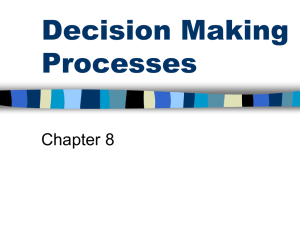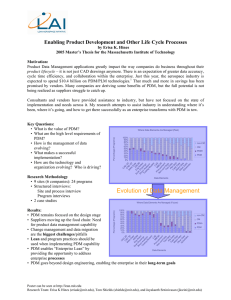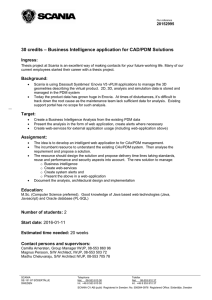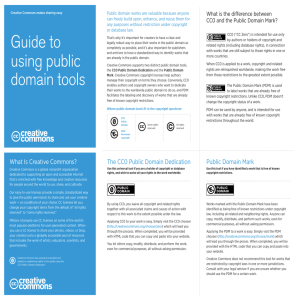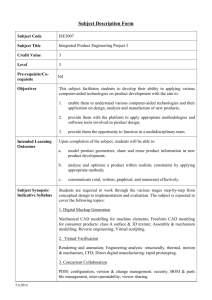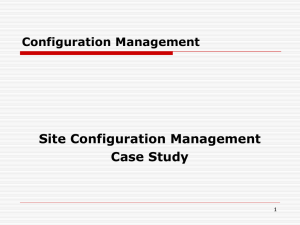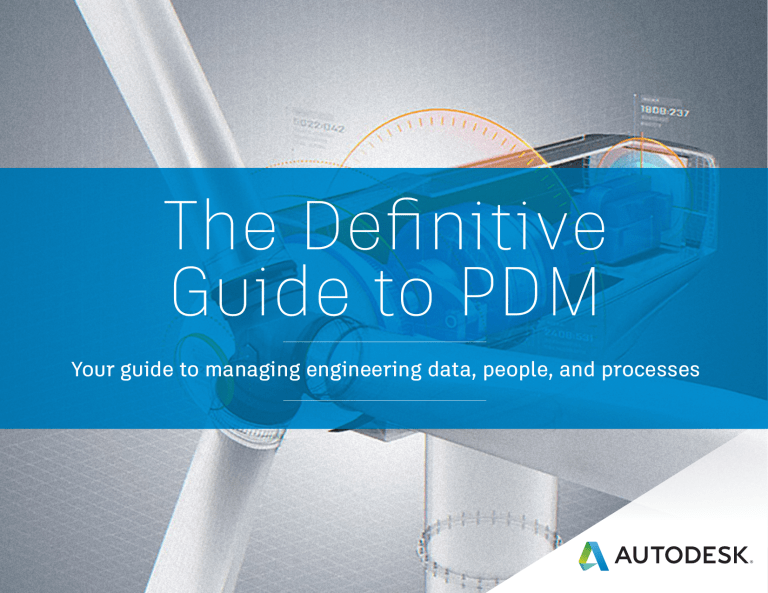
The Definitive Guide to PDM Your guide to managing engineering data, people, and processes Introduction Engineers spend, on average, 15 percent of their time managing data—and some routinely waste the equivalent of one day a week or more. Then, when you need to share this data with colleagues, you have to release and track a series of PDFs, spreadsheets, and design files, and it only gets more complicated when working with third parties. Much of this waste is due to the simple fact that Windows Explorer wasn’t made for engineers. And it certainly wasn’t made to manage and collaborate with CAD files. The Definitive Guide to PDM | Introduction 2 Which common data management and collaboration challenges do you experience most often? When sifting through thousands of files, you wish you could search for more than just a file name. Too often, the data you’re looking for is spread across local drives on individual workstations and shared folders on assorted servers. You dread copying or renaming files. It’s tedious and you typically need to repair broken references. When you work with other engineers on a project, you worry constantly that they will overwrite your files. You manually maintain spreadsheets that document every instance where parts and subassemblies are used. When you need to work with external parties or multi-site staff, file formats and firewalls lead to complications. To overcome these challenges, you need a file manager that’s made just for engineers. It should understand the complexities of CAD file relationships, help you find the files you need when you need them, and, most importantly, make it easy for you to collaborate with your colleagues. The Definitive Guide to PDM | Introduction 3 What is PDM? When you catch a cold, you usually won’t start feeling well again until you make a trip to the doctor or do something to treat the illness. Problems managing your documents, design files, and data work the same way. If you ignore them, they aren’t going to go away. In fact, they’ll probably only get worse. Think of PDM as your cure-all remedy. It’s a one-stop-shop for all product-related information and engineering processes, where everyone on your team and each of your collaborators can come together. The Definitive Guide to PDM | What is PDM? 4 What is PDM? A strategy for managing your product-related information and engineering processes—all in one spot. PDM comes down to data, people, and process. Data is all about managing the files and metadata that make up the source code for your product. People is about the challenges your engineering and non-engineering staff have while developing the product. Process is about the challenges with maintaining standard procedures throughout development. The Definitive Guide to PDM | What is PDM? 5 Managing design files Personal data management Maintaining control over your documents can make or break the success of your projects, especially when it comes to deadlines. But countless factors can undermine your efforts, like unorganized and unprotected shared network folders, messy and unmaintained spreadsheets, and hardware failure. This leaves your intellectual property at risk, and data difficult to find and reuse. PDM solutions can help you keep your data safe by keeping it in one place, setting permissions, backing up your data, and tracking files and revisions. Finding data When engineers are asked about their data management challenges, they typically identify search and retrieval of design files as top issues. In fact, 46 percent of those involved in product development cite “finding the right information” as a top design challenge. The Definitive Guide to PDM | Managing design files 6 Finding a file should be a simple task. But too often, the data you’re looking for is spread across local drives on individual workstations and shared folders on assorted servers. There’s also the problem of volume: With multiple people contributing to hundreds of projects, thousands of files can accumulate over time, and the only criteria you can consistently search for is the file name. Top Design Challenges Related to Data Management Sharing info w/ other departments 49% Finding the right information 46% Managing change 43% Working on wrong/ outdated data 35% Reusing data 29% Managing design projects 29% Collaborating w/ engineers in different locations Sharing info externally 26% 25% This all adds up to a lot of wasted time. When you can’t find the files you need, you may end up wasting even more time designing something that may already exist, which is compounded by the need for additional investments in tooling or redevelopment of manufacturing processes that were already available for the design you couldn’t find. These situations make clear why Windows Explorer is simply not up to the task. The Definitive Guide to PDM | Managing design files 7 With a PDM strategy in place, you can: Search for more than just file names PDM systems are designed to fundamentally understand CAD files, so all file-related properties are indexed and searchable. This includes default properties that are cataloged automatically or custom properties that you can map to parameters or characteristics unique to your designs. Use multiple search criteria It’s likely many of your designs have many similarities, so when trying to identify the few relevant items you’re looking for, you may need to conduct a detailed search. Having the option to use several different properties and Boolean operations to filter down results is extremely useful to find just what you need. Save your common searches You probably need to conduct the same types of searches over and over again. Saving your searches gives you one-click access to common things like documents you are working on or important files in the project. The Definitive Guide to PDM | Managing design files 8 Reusing designs The endless search for files isn’t the only way inefficient data management can sap your productivity. Twentynine percent of engineers report that reuse of data is a top design challenge. Copying files The complexity of CAD files is a root cause for issues around data reuse. Instead of housing everything in a single file, links are built between parts, subassemblies, and top-level assembly files. Playing around with those files in Windows Explorer can cause things to break quickly. To reuse designs, you will eventually need to find a way to copy the data and give it a new name. Just try moving, renaming, or opening a copied file, and odds are all of those references will be severed. That means you’ll need to spend time pairing everything back up inside your CAD software. There are better ways of copying designs built inside most CAD applications, but the task remains tedious and repetitive. For example, if you have an assembly with hundreds or thousands of parts, it is extremely inefficient to manually select each file you want to copy, rename each copied file, specify the destination location for each new file, and confirm everything worked properly. Design changes Since design reuse is such a common activity, another significant data management challenge is determining the total impact of a design change to a part or subassembly that is used in multiple products. Windows Explorer can’t tell you that. More than likely, you manually maintain a few spreadsheets that list all the files used in top-level assemblies and subassemblies. This approach does work, but keeping those spreadsheets up to date can be time consuming. History Finally, going beyond just reusing data, many engineers don’t have a way to revisit past engineering decisions to understand the rationale behind them. For instance, why was a change to a certain design needed? And what approach did they take to implement the change? The Definitive Guide to PDM | Managing design files 9 Moving, copying, and renaming files Reusing existing designs saves development time as well as manufacturing and tooling costs, but the process should not undermine your productivity. A PDM strategy removes the repetitive tasks and frustration involved with the technical aspects of reusing existing data, giving you more time to work on what’s actually new in the design. Here’s how: Drag and drop PDM systems are generally designed to provide similar usability to Windows Explorer with the added benefit of not breaking things when you make changes. So, you can drag and drop a file or folder within the system just as you would do normally, without worrying what will happen the next time you open it or another file where it is used. Rename anything With PDM, you can rename files exactly as you would inside Windows Explorer; the difference is that PDM software makes sure all links remain intact. You can also use tools to apply naming schemes to entire batches of files. This is especially useful when copying a design or working on a project that involves hundreds or thousands of files. Copy design One of the most powerful tools a PDM solution can provide is the ability to simplify design reuse into a single step. Once the top-level assembly is selected, every file referenced in the assembly is identified and included in the copy operation. From there, you can pick and choose which files you want to copy, reuse, or remove from the new project, and then define a scheme for renaming the copied files. See where parts or subassemblies are used Since relationships between files are already being tracked, in a single click you can see everywhere a part or subassembly is used. PDM works in the opposite direction as well, allowing you to see every file used by a part or assembly. The Definitive Guide to PDM | Managing design files 10 Collaboration Whether your team sits in the same office or is distributed across different locations, developing data management systems determines how efficiently and safely you can operate and can free up your time for design and innovation. PDM solutions offer concurrent design functionalities, keeping all your data in one place, even if your team isn’t. Distributed teams face significant collaboration issues. In fact, 26 percent of teams noted this as a top design challenge. Sharing information simply becomes more difficult with distance. The primary problem with distributed teams is that everyone is not working from the same set of data. If a team in one location updates a file, then engineers in another may not know about it until it’s too late. It can also hamper productivity if secondary sites have delays in accessing design data. And it goes beyond just the data itself–offsite team members can have issues participating in engineering workflows–such as change orders or design reviews. For these reasons, good PDM solutions should grow as you grow, providing scalability for global access. With multi-site capabilities for distributed teams, everyone can access the data they need, whether they are working from an office, working from home, or working from the road. Windows Explorer lacks some basic capabilities that engineers need. For example, there is no simple way to prevent other people working on the project from accidently overwriting your files in a shared folder. To prevent this from happening, you need to be able to lock down files while you’re editing them. The Definitive Guide to PDM | Collaboration 11 Your team also must be disciplined about properly maintaining versions of designs. However, tasks that rely solely on discipline are likely to fail eventually due to human error. Storing files on shared network folders creates additional collaboration issues, particularly with larger teams. A few dozen engineers opening files directly from shared folders and saving often (as they should) can strain network capacity. Pulling the files down to the local computer while editing reduces the traffic, but creates more opportunities for data loss. It also makes it more difficult to find files, since they can be anywhere at any time. And with different versions of the same part or assembly in many different places, it is hard for your team to answer the question: “Which one is the most up to date?” The Definitive Guide to PDM | Collaboration 12 More effective collaboration with PDM Here are some specific ways PDM helps engineers to collaborate internally more effectively: Checking out, checking in PDM solutions remove all concerns about overwritten files with a simple yet fundamental capability: check out and check in. Just like your local library, when you check out a file, nobody else can touch it until you check it back in (it becomes “read-only”). While it’s checked out, everyone can still find the file and see who is actively working on it, so you know exactly which user to track down. Versioning Versioning capabilities keep track of all the changes you make during the design of the product while maintaining the same file name. It logs the who, what, and when behind each change, providing traceability and context for each update to the design. You always know which version is the latest. When paired with check-out/check-in capabilities, versioning prevents conflicts from developing when multiple engineers are contributing to the same files in the project. Working locally, saving globally Most PDM systems operate under the principle that data is best stored in a place with global access, but edits should be made locally. When you check out a file, it is faster and less draining on the network to download the file once to your local workstation, save locally as you edit the design, and then upload it back to the server as a new version when your changes are complete. This process helps to protect against data loss because the original file still resides on the server. It also ensures all files remain searchable and discoverable even when checked out. The Definitive Guide to PDM | Collaboration 13 Beyond the firewall Oftentimes, external file sharing is entirely uncontrolled. With PDM, you can collaborate outside your organization while maintaining control over data. Here are three ways that PDM can make collaboration easier: Multiple sites Replicate your data at multiple sites. Even at small and midsize manufacturers, product development is often handled by teams distributed all over the world. In these cases, PDM software becomes essential because it can replicate your data across work sites, ensuring all contributors—no matter where they are located—are working on the latest information. This includes not only design files, but also important metadata about the files; for example, is the file checked out, who is editing it, and what is its current life cycle state? Controlled access Provide controlled access to data outside engineering. PDM can provide groups outside of engineering with access to data, and helps ensure those groups don’t see or change things they shouldn’t. Many PDM systems also provide a web client that makes it easier for non-engineering users to access, search, and view designs compared to using a full PDM desktop application that must be installed on their computer. Direct access Allow customers and suppliers direct access to design data. Similar to your internal teams, chances are you need to provide your suppliers and customers access to engineering data. Depending on the amount of work they are doing, you can use PDM to provide access to individual files or entire projects. The degree of access is entirely customizable, so these users can view or edit only the files that are relevant to their work with you. The Definitive Guide to PDM | Collaboration 14 Beyond CAD file management If you manage your CAD files with PDM, then you have taken the first critical step in developing your PDM strategy. Now, the seemingly uncontrollable design files your engineering team creates are under control. With PDM in place, it’s likely your engineers waste less time, your product costs are going down, your product quality is improving, and your development cycles are shorter because your engineers are working better as a team. But PDM is about more than managing CAD files and facilitating collaboration. The second phase is looking at the engineering workflows and processes that are centered around that data, such as managing change, design reviews, project management, and bills of materials. Image courtesy of Balzer Pacific Equipment Co. The Definitive Guide to PDM | Beyond CAD file management 15 Release and change process The tracking of ECO and release processes ranks among the most common challenges cited by engineers involved in product development. Ensuring everyone knows where the design is in the overall life cycle, soliciting feedback from others, and knowing the status of projects are all areas generating inefficiency in the development process. The source of this inefficiency is often highlighted by the inability for non-engineering staff to participate. For design reviews especially, getting guidance from multiple points of view can be extremely valuable, but often is not done because it is too challenging to provide the necessary data and collect their feedback. From a project management perspective, when multiple versions of a design file exist on shared folders, it’s nearly impossible to understand whether one has been released and what changes occurred from one to the next. Managers cannot monitor overall project status because there is no central place to review progress of all the data being created. The Definitive Guide to PDM | Beyond CAD file management 16 Versioning While versioning captures the everyday, incremental changes to the product, it does not communicate the current life cycle state of the design to others. Knowing whether a version is still a work in progress; in review; undergoing a change; or being released to manufacturing is essential so everyone is working from the right data. Ensuring stakeholders have access only to the right data at the right time is a process that needs to be handled carefully and, often, manually. Review and approval Even in environments where the entire design process has gone digital, the review and approval processes for product releases and changes often remain paper-based. Engineers shepherd manila folders with checklists and drawings around the office for days, if not weeks, to obtain the necessary reviews and approvals. And once changes and releases are approved, all those folders likely get stashed away in a file cabinet, locking away hard-earned, valuable knowledge. Tracking and control Because the entire process is happening offline, it is impossible for anyone to see project status easily. There is no transparency into who might be holding things up; major issues in the design that may cause delays; or how close a project is to completion. This all leads to uninformed decision making because data isn’t available on demand. The Definitive Guide to PDM | Beyond CAD file management 17 PDM solutions Managing your release and change processes is one of the most high-impact ways to grow your PDM strategy. It removes uncertainty and inefficiency inherent to the development process. Not only can you proceed through the process faster, but you also are able to include more people, gather more feedback, make better decisions, and ultimately, create a better product. Here are some ways PDM can help your entire team manage engineering release and change more effectively: Life cycle states Assign life cycle states to your designs. Life cycles let everyone know the current state of the design—be it work-in-progress, out for review, or released to manufacturing. Managers can easily check the current status of a single design or an entire project to help in their decision-making process. You can also control access to files based on the assigned state so groups outside engineering see only the version of the data they need. Life cycles also help control the process by allowing you to define rules for who can change the life cycle state and what steps they need to take prior to doing so. ECO process Automate your ECO process. Rather than traversing the “sneaker network” to get everyone’s sign-off, you can set up a standard or custom workflow inside your PDM software so people are notified when they have a task due. Everyone can see current status and who might be holding things up, which usually helps move things along a little faster. Review and feedback Include more people in review and feedback cycles. Collecting feedback from people in all different functions is fundamental to concurrent engineering. With PDM, you can give everyone the right level of access and make participation in design reviews easier. In addition, all feedback is stored and searchable, so knowledge can be built up over time and made available to the entire engineering team. The Definitive Guide to PDM | Beyond CAD file management 18 Managing BOMs If you manage your CAD files inside a PDM system, relationships are traced and you can easily see the full product structure. But your BOMs are likely handled separately—manually managed in a spreadsheet or in another system disconnected from all your design data. This disconnect between your product data and your BOM can hamper productivity and create far-reaching issues due to BOM inaccuracies. The most important aspect of your BOM is that it reflects the latest release of each component in the product. Maintaining one accurate version is a challenge given how quickly your engineers are making changes to the product throughout its development—and after its release. When you factor in that suppliers, manufacturing, service, purchasing, and your enterprise resource planning (ERP) system all use the BOM as well, making sure everyone is working from the correct version is a nearly impossible task. As the complexity of your products and varying product lines increases, so does the work required to maintain your BOMs. A single BOM with thousands of items managed in a spreadsheet is inefficient. Managing a massive item master in a spreadsheet when components are reused across different products is incredibly unproductive. Opportunities to reduce costs are missed and a single incorrect item can set back production until it is corrected. The Definitive Guide to PDM | Beyond CAD file management 19 PDM solutions Improving how you create, maintain, and share your BOMs can have several benefits—less inefficiency, fewer inaccuracies, and more time spent on value-added work to the project. PDM also helps downstream and outside groups to perform their roles more effectively. In addition, all your enterprise systems, such as ERP or manufacturing resource planning (MRP), are always current—preventing costly errors from making their way into procurement and production. Here are some specific ways that PDM can help you improve BOM management: Manage BOMs Manage BOMs where you manage your product data. By creating a direct link between your BOMs and the design files they apply to, the manual effort required to keep them up to date is virtually eliminated. BOMs can be created automatically based on the product structure of the top-level assembly, bringing along all the components, quantities, and revision information with them. And you still have the option to add line items manually to your BOM for consumables or spare parts that may not be included in the design itself. BOM revisions Control BOM revisions. When managed inside a PDM system, you can use the same life cycle and revision controls for your BOMs that you use for design files. This helps you track and compare changes between revisions and control access to downstream stakeholders so they only have access to the latest released version of the data. Enterprise systems Connect to enterprise business systems. As fun as manually entering your BOM data into an ERP system can be, automatic data transfer allows you to make much better use of your time. Your PDM system becomes the master location for the BOM, and connections can be built to any other business system you use, so they’re always accurate and up to date. Source: Tech-Clarity Perspective: Best Practices for Managing Design Data, Tech-Clarity, Inc. 2012. The Definitive Guide to PDM | Beyond CAD file management 20 Can a PDM strategy really make a difference? Consider the facts: World-class manufacturers are 30 percent more likely to use PDM or product lifecycle management (PLM) to manage their design data; these top performers also spend 25 percent less time on non-productive data management tasks. PDM is likely to have a positive impact on your efficiency and productivity, too. See Solutions
